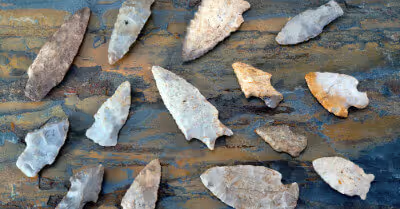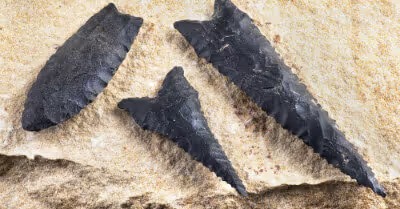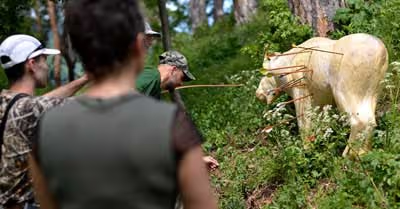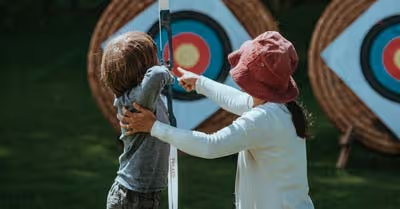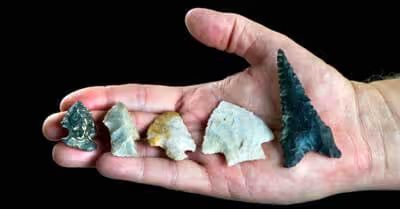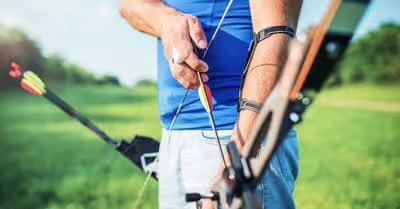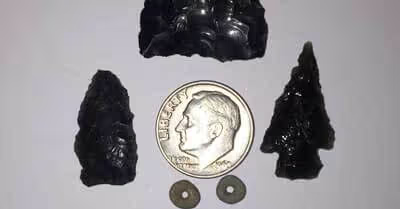Table of Contents
How to pick a compound bow
It is very important to pick a bow with a reputation for durability. Your bow must also be appropriate for your height. Speed also matters but is somewhat less important.
Draw weight
Draw weight is one of the most important considerations. You need a bow that is well suited to your strength. Don't use a bow that you find difficult to pull back; you won't hunt or shoot targets well with a bow like that.
A bow with a higher draw weight can shoot arrows farther and faster than a weaker bow. However, you should not get the strongest bow you can shoot. Instead, you should get the strongest bow you can shoot without much effort - you won't do as well if you can barely pull the bow back.
With a compound bow, it is the hardest to pull the bowstring when the bow is 3/4s of the way to being fully drawn. After you fully draw the bow, it is easier to hold the arrow in place. This is one of the advantages of compound bows over traditional bows.
Especially for your first bow, you might get a bow that allows you to adjust the draw weight. You may get stronger with practice, so you should be able to switch to a higher draw weight as you get stronger.
Draw length
Another crucial measurement to get right is the bow's draw length. A bow may allow you to adjust the draw length, but usually not by much. Make sure you get the draw length right, or else you may spend several hundred or more dollars on a bow you don't like.
A draw length of 30 inches means that you can pull the bowstring back 30 inches before you fire. A bow with a 30-inch draw length would be best for a tall person, around 6'3. Take your height in inches and divide it by 2.5, and that is roughly the draw length you need.
You might like a bow that is a little longer or shorter than your height suggests. You will never be good with a bow for someone of a very different height, but the numbers are only a rough guide. Try a few bows before you buy one.
Just as a bow with a higher draw weight tends to be better if you can easily handle it, a longer draw length tends to be better as well, as long as it is not too long for you. A bow with a longer draw length will fire arrows faster.
What are the parts of a compound bow?
Before you learn any more, you should know a little about the parts of a compound bow. You should not buy anything without knowing the terms.
The cams
The cams are pulleys and are what make a compound bow different from a traditional bow. The pulleys multiply the force of your muscles and allow you to pull the bowstring back a lot farther than you could with a traditional bow. This allows you to fire an arrow faster than with a traditional bow, sometimes at more than 350 feet per second.
Different compound bows use different designs, as the technology is still being experimented with and improved upon. A bow might use a top cam and a bottom cam, or only one cam. Some bows use an experimental system that does not resemble typical compound bow mechanics.
The axle
The axle connects the cams to the frame of the bow. It is vaguely similar to an axle on a wheel.
The riser and the limbs
This is the backbone of the bow, the middle part between the two limbs. The riser is the frame that holds the rest of the bow together. At the two ends of the riser are the limbs of the bow. If you stand the bow up straight, the riser is vertical, and the two limbs are roughly horizontal.
Some bows have solid limbs; others are split down the middle. Usually, split limbs are a better choice, though it is no guarantee that a bow with split limbs shoots better. Bows with split limbs usually vibrate less, which makes them more accurate.
The bowstring
The string on a compound bow is used just like the string on a traditional bow. It is what you nock an arrow onto and what you pull back to launch your arrow. A bowstring is never supposed to stretch more than a tiny bit, either on a compound bow or a regular bow.
Modern bow strings are made of synthetic materials and are very tough, but they still wear out after a few years or less. You should always replace a bowstring as soon as it starts to weaken, not wait until the string breaks. It is dangerous when a string breaks, and even if no one is injured, it can still damage your bow.
The buss cables
The cables are separate from the bowstring and help the pulley system work properly. The cams would not work without the cables. Be careful not to damage your cables.
Grip
This is the part of the frame where you hold the bow. It is not at the exact center of the bow. Instead, it is a little away from the center and towards one end.
Which of your eyes is dominant?
Just as people can be either left-handed or right-handed, everyone has a dominant eye. Most people do not put much thought into what their dominant eye is. However, it matters in archery.
Usually, a right-handed person has a dominant right eye, but many people have a dominant right hand and a dominant left eye or the other way around. If your dominant hand and your dominant eye do not match, this is known as cross-dominance.
Unfortunately, cross-dominance makes it harder to learn archery. You can still get very good at it if your dominant hand and your dominant eye do not match, but it will take longer.
If your left eye is dominant, you might do best if you learn to shoot left-handed even though you use your right hand. Developing motor skills with your left hand can, of course, take time.
Another option is to train your non-dominant eye. Learning to shoot with your right eye even though your left eye is dominant can also take a long time. However, cross-dominance does not prevent you from reaching a high level of skill; it only makes archery take longer to learn.
Many people are left-handed and have dominant left eyes. These people should always get left-handed bows and not try to train with a right-handed bow.
Left-handed compound bows are not hard to find. If you use a left-handed bow, you will pull the string with your left hand and hold the grip with your right hand.
Axle to axle length
Not only do bows vary in overall length and draw length, but in axle to axle length as well. The axle to axle length is the length from one cam to another. The measurement is from the center of one cam - the axle - to the other cam's center.
While axle to axle length matters less than draw length, you should go with a longer axle to axle length if you are a beginner. It can be harder to control a shorter bow.
Start with a bow that is ready to shoot, don't buy accessories separately
Some bows are sold "ready to shoot," which means that they come with all of the accessories you need to use the bow. Other bows do not come with accessories. You will have to pick out an arrow rest, a sight, and a quiver before you can use a bow that is not ready to shoot.
If you have never bought a bow before, go with one that comes with the necessary accessories. Unless you are experienced with compound bows, you could end up buying the wrong items for your bow.
Single cam bows VS dual cam bows
Single cam bows are easier to tune than dual cam bows, so they are better for beginners. Single cam bows are also more accurate, so an experienced archer or hunter might also prefer a single cam bow.
Dual cam bows have the advantage of firing faster arrows. Since there are two wheels or cams, the bow stores more energy and is more powerful. It is also easier to maintain good form with a dual cam bow because of the more solid back wall.
What are "hard" cams and "soft" cams?
Today, these terms may no longer be meaningful because almost all bows today are hard cam bows. A soft cam bow did not accelerate the arrow as fast and was not as powerful. Today, any new bow can propel an arrow fast enough to be considered a hard cam bow.
What are "one and a half cam" bows?
A one and a half cam bow is a new, complex type of two cam bow. While it uses two cams, the two wheels are not the same, and only one provides the arrow with more power. They are a middle ground between single cam bows and dual cam bows.
One and a half cam bows require tuning the way two-cam bows do. However, a one and a half cam bow will still fire reasonably well even if the tuning is imperfect. You will not have to adjust the tuning as often as with two cam bows.
The best choice for beginners is the single cam bow. Focus on learning archery, not learning to maintain a two cam bow.
Speed
Speed is relevant in bowhunting. The faster your arrow flies, the harder it is for your prey to avoid.
Compound bows can fire arrows at 300, 320, or 340 feet per second. The speeds that companies advertise can be misleading - these speeds may make assumptions such as a long draw length, heavy draw weight, and light arrows. A typical arrow won't fly as fast as the company advertises.
While speed is an advantage, it is not essential. It is more important to pick a durable bow that is well suited to your size and strength. You can easily hit a deer with a slightly slower arrow - don't think that a relatively slow bow is a poor one.
Weight
Since many or most compound hunting bows weigh less than five pounds, you are not likely to get tired holding or carrying a bow. Hunting bows are light.
However, weight is still relevant because it is easier for a beginner to handle a heavier bow. At higher skill levels, people prefer lighter bows.
Material, quality and durability
The last thing you want to buy is a flimsy bow that will break before long. Make sure you buy quality. Ideally, it would be best if you asked someone you know to recommend a good bow.
If you do not ask anyone in person, make sure the reviews are positive on more than one website. If the reviews are numerous and positive on Amazon, you might still double-check the bow's quality on another website or two.
Different bows have risers made out of different materials. A riser can be made of aluminum, carbon fiber, or something else. Durability is very important, much more so than speed.
Is carbon fiber better than aluminum?
Aluminum is a good material for making bows - it is light, cheap, and strong. There are more aluminum bows to pick from than carbon fiber bows to pick from.
However, carbon fiber is a somewhat better if more expensive choice. Carbon fiber is even tougher stuff, and it won't get too hot or cold the way aluminum will in the summer or winter. The difference is not huge, so get a good aluminum bow if you find one, but carbon fiber has a bit of an advantage.
Accessories
If you are buying accessories yourself, instead of buying a bow that is ready to shoot, there are several things to buy, some more essential than others.
Release aid
A release aid makes your shooting more accurate, both for newbies and for experienced shooters. When you let go of an arrow, you may end up nudging it just a little in one direction or another, and a slight nudge can make you miss a deer or a target. Release aids help you achieve a "clean release" where the arrow goes where you want it to.
Sight
Since a sight with a lens makes a big difference, so every archer should invest in one. After you buy a sight, you will have to adjust it yourself before it helps you.
Go to an archery range and test the sight out. If your arrows are repeatedly landing too high, adjust the sight so that your arrows land lower. A sight will harm your ability to shoot if it is not adjusted right.
Arrow rest
An arrow rest is where the front part of your arrow rests when you are aiming the bow. Unlike a recurve bow, a compound bow requires an arrow rest and will not work well if you try to use it without one.
If you buy a bow that does not come with an arrow rest, expect to spend more than $50 or more than $100 on it. There are different kinds of arrow rests. Hunters often prefer launcher style rests, while target shooters prefer blade rests.
Clicker
New archers may have trouble being able to tell when the bow is pulled back just far enough. A clicker can help you by making a clicking sound when your bow is pulled back all the way.
If you are buying a bow that does not come with a clicker, you need to know your bow's draw length to buy the right clicker. A clicker will not work if it is for a bow of a different draw length.
Quiver and case
Some quivers attach to your belt and have enough room for several arrows. Other quivers attach to your bow and hold fewer arrows; these are bow-mounted quivers.
When hunting, be careful not to make any noise when pulling an arrow out of your quiver. It is easy for an animal to detect you if you make a bit of noise.
Recent Articles



